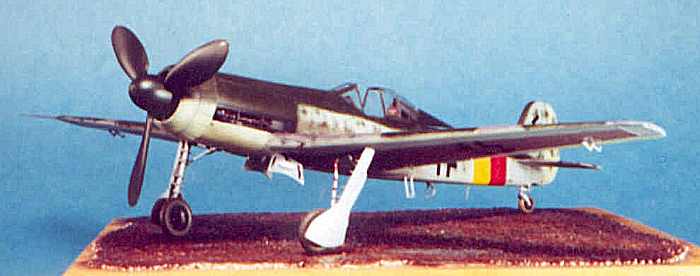
Italeri 1/48 Ta-152H-1
|
KIT # |
861 |
|
PRICE: |
$28.00 |
|
DECALS: |
See Review |
|
REVIEW : |
|
|
NOTES: |
Kit is ex-Dragon/Trimaster |

|
HISTORY |
The Ta-152H was developed from the Ra-1/Ra-6, a series of related designs submitted by Kurt Tank in response to a request from the RLM in late 1942 for a Hochleistungsjaeger, high-performance high altitude fighter. When the Technischen Amt accepted the Focke-Wulf proposals in mid-1943, Tank was accorded the unusual honor of having the new type designated after him, rather than being given a new "Fw" designation. The series became the Ta-152, and the Ta-152H was the only one of these to see any operational service before war's end.
The Ta-152H, with a longer fuselage and greater wingspan than any other Focke-Wulf Fw-190 development, first appeared in prototype form in late 1944, when the Ta-152 V3, V4 and V5 were delivered to Langenhagen. Powered by a Jumo 213E in-line engine, and armed with a 30mm Mk108 Motorkannon and two 20mm MG151s in the wing roots, the airplane had a pressurized cockpit that gave the equivalent cabin altitude of 16,500 ft. at 35,000 ft.
The first Ta-152H-0s, which lacked the wing fuel tanks and MW50 and GM1 systems of the operational Ta-152H-1, were in service with Erprobungskommando Ta152 in November and December 1944, under the command of Hauptmann Bruno Stolle.
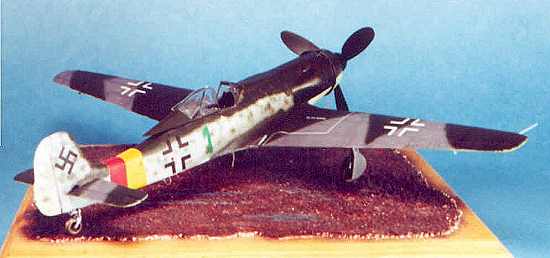 Most of the Ta-152H-1s
delivered for operational service in February and March 1945 were equipped with
the R11 Ruestsatze, which included all-weather instrumentation.
Approximately 150 Ta-152H's were produced by the Focke-Wulf factory at Cottbus
before the factory was abandoned in the face of the Soviet advance in April
1945.
Most of the Ta-152H-1s
delivered for operational service in February and March 1945 were equipped with
the R11 Ruestsatze, which included all-weather instrumentation.
Approximately 150 Ta-152H's were produced by the Focke-Wulf factory at Cottbus
before the factory was abandoned in the face of the Soviet advance in April
1945.
One pilot who flew the Ta-152H recalled that, "The flying characteristics of the Ta-152H put all previous German fighters in the shade. Although I never flew the Me-262, I would venture to say that the Ta-152 was by far the superior when it came to dogfighting with the Allied fighters then in service. In my opinion, there was no better fighter in operational service at the time."
Oberfeldwebel Willi Reischke of the Stabschwarm, JG301 - the only unit to take the Ta-152H into battle - had the opportunity on April 14, 1945, to demonstrate the truth of what the Ta-152H could do as a dogfighter. The four aircraft of the Stabschwarm were scrambled to intercept two enemy fighters that were strafing ground targets a few miles from the field at Neustadt-Glewe. The Schwarmfuehrer's wingman unexplicably dove into the ground as they dove to attack what turned out to be two Hawker Tempests, as Reaischke fastened on to one of them in a dogfight that never went above 500 feet AGL. "At this altitude," recalled Reischke, "neither pilot could afford to make a mistake, and it was now that I began to fully appreciate what this airplane could do." He pulled tighter and tighter turns, never approaching the limits of the Ta-152's capability. When the Tempest pilot - unable to shake his pursuer - tried to flick turn in the opposite direction, Reischke gave him a full burst, and then his guns froze. He stayed in position where his opponent would be able to see him, and literally flew New Zealand Warrant Officer O.J. Mitchell into the ground by forcing him to turn so tight the Tempest entered a high-speed stall/spin.
Reischke scored a total of 3 kills in the Ta-152H in the closing weeks of April 1945. His comrade Feldwebel Joseph Keil, scored five kills during this time to become the only Ta-152H ace.
Reischke's airplane, "Green 6," was surrendered to the RAF at the end of the war. It was disassembled and flown to Farnborough, where it was reassembled and flown twice by British test pilot Eric Brown, who was not a fan of the aesthetic of the Ta-152 in comparison to the earlier Fw-190 series airplanes he had flown; he was highly impressed by its power though, even without the MW50.
|
THE KIT |
The Ta-152H was one of the first releases by Tri-Master, back in the late 1980s, and as such was one of the kits that started the "revolution" in plastic model airplane kits. At the time, the kit was released with injection molded parts, white metal landing gear and photoetch detail parts, which was a first for most modelers when they saw it. I remember that, at a price of US$45 then, it was the most expensive plastic airplane kit I had ever seen, and I took a "pass" on it. After Tri-Master priced itself out of business, the kits were picked up by DML and released at lower prices. By this time, the white metal landing gear was replaced with injection-molded plastic parts. I have to say that - at the time - I agreed with Captain Eric Brown about the "aesthetic failings" of the Ta-152H, and the only reason I built one was Ed Maloney at The Air Museum, "Planes of Fame," asked me to.
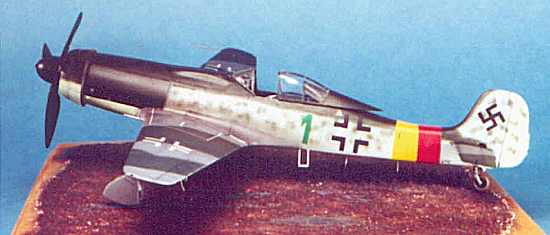 Within the past year,
the model has again been released, by both Hasegawa and Italerei. The Hasegawa
release is essentially the same as the earlier DML release, with the photoetch
details and the rest of the kit in injection plastic. The Italerei kit is all
injection-molded plastic, and does not include the Jumo 213E engine that was
part of the original model and is available in the Hasegawa offering. This is
unfortunate, since the liquid-cooled Focke-Wulfs all had open gear wells,
through which one can see the engine. So long as the model is sitting on its
gear, however, this is not so noticeable. I really don't understand why Italerei
did this, since their engineless kit sells for the same price as the Hasegawa
kit - which was a limited release and therefore not so easy to find now.
Within the past year,
the model has again been released, by both Hasegawa and Italerei. The Hasegawa
release is essentially the same as the earlier DML release, with the photoetch
details and the rest of the kit in injection plastic. The Italerei kit is all
injection-molded plastic, and does not include the Jumo 213E engine that was
part of the original model and is available in the Hasegawa offering. This is
unfortunate, since the liquid-cooled Focke-Wulfs all had open gear wells,
through which one can see the engine. So long as the model is sitting on its
gear, however, this is not so noticeable. I really don't understand why Italerei
did this, since their engineless kit sells for the same price as the Hasegawa
kit - which was a limited release and therefore not so easy to find now.
The decals for the Italerei kit are done by Cartograph, and are thick enough to cause trouble using them. Unfortunately, there are no aftermarket sheets for the model, so the only other way to finish it is to have decals from the dungeon, and perhaps the Aeromaster Fw-190 stencil sheet.
|
CONSTRUCTION |
Construction of the model is straightforward, and fit is still as good as it was when I built one ten years ago. These kits were among the first "fall together" models, and I found I only had to use Mr. Surfacer on the fuselage centerline seam to get a very acceptable model ready for painting. My only changes were to substitute a blown hood from an Italerei (DML) Fw-190D-9 for the canopy in this kit, which was both thick and a bit too angular in its look, and to use Eduard photoetch Luftwaffe seat belts for the cockpit.
|
PAINT & DECALS |
Painting:
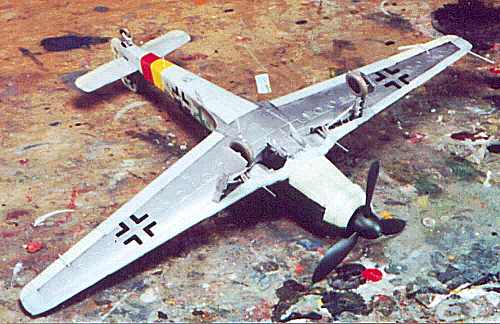 I preshaded the model
with flat black along all panel lines, then painted the lower wing and wheel
wells, and the landing gear, with SnJ Aluminum. Once this was dry, I masked over
the natural metal area of the wing. I then painted the JG301 Reichverteidigung
band in Gunze-Sanyo Rot 23 red and Gelb 04 yellow, then masked of
the area. I painted the lower camouflage first, doing the fuselage center
section "RLM 84," using Gunze-Sanyo "Sky" for this. The
control surfaces and the engine cowling were painted RLM76, again using the
Gunze-Sanyo color. The upper fuselage was painted overall RLM83 Dark Green,
while the wings were painted RLM75 Grauviolett and RLM83 Dark Green, with
Gunze-Sanyo. I make my own RLM75, by mixing Gunze-Sanyo Dark Sea Grey and
Neutral Grey 50-50 to get a color midway between them, since both these colors
in the Gunze range have a distinct violet hue that is missing from their version
of RLM75. The prop was painted RLM70 Black-Green.
I preshaded the model
with flat black along all panel lines, then painted the lower wing and wheel
wells, and the landing gear, with SnJ Aluminum. Once this was dry, I masked over
the natural metal area of the wing. I then painted the JG301 Reichverteidigung
band in Gunze-Sanyo Rot 23 red and Gelb 04 yellow, then masked of
the area. I painted the lower camouflage first, doing the fuselage center
section "RLM 84," using Gunze-Sanyo "Sky" for this. The
control surfaces and the engine cowling were painted RLM76, again using the
Gunze-Sanyo color. The upper fuselage was painted overall RLM83 Dark Green,
while the wings were painted RLM75 Grauviolett and RLM83 Dark Green, with
Gunze-Sanyo. I make my own RLM75, by mixing Gunze-Sanyo Dark Sea Grey and
Neutral Grey 50-50 to get a color midway between them, since both these colors
in the Gunze range have a distinct violet hue that is missing from their version
of RLM75. The prop was painted RLM70 Black-Green.
Decals:
I used the kit decals, after I was unable to find a green 6 to do Willi Reischke's airplane. "Green 1" is likely the Ta-152 flown by OberstleutnantAufhammer, schwarmfuehrer of the JG301 Stabschwarm. As stated above, these are Cartograph decals, and on the thick side. Once I had them down with Micro-Sol, I was forced to apply Solvaset to get them to sink into the recessed panel lines.
Final Assembly and Finish:
I attached the landing gear and the aileron actuators when finished with the final coat of Flat Future, and positioned the canopy open. I figured the airplane didn't see enough service to be really dinged up, other than around the wing root where the pilot entered the cockpit. I used Tamiya "Smoke" for the exhaust stains and gunfire residue around the wingroot weapons.
|
CONCLUSIONS |
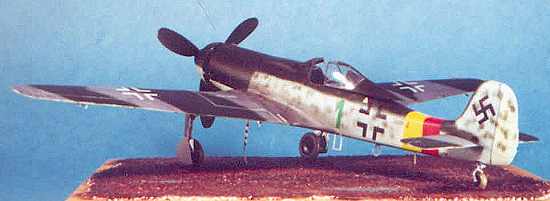 I have changed my mind
about the aesthetic of the Ta-152H. To me, it still looks like an Fw-190 after
being put on the rack by the Spanish Inquisition, but there is a certain grace
about it, and with those glider-like wings there are few other aircraft with a
similar look. (In fact, I can't think of any.) With my lineup of Focke-Wulf's
now stretching from Fw-190A-3 through to Ta-152H-1, the collection is looking
good.
I have changed my mind
about the aesthetic of the Ta-152H. To me, it still looks like an Fw-190 after
being put on the rack by the Spanish Inquisition, but there is a certain grace
about it, and with those glider-like wings there are few other aircraft with a
similar look. (In fact, I can't think of any.) With my lineup of Focke-Wulf's
now stretching from Fw-190A-3 through to Ta-152H-1, the collection is looking
good.
This is definitely an oldie that is still a goodie. If you can track down the Hasegawa kit with the engine, it is the preferable model, though I understand some of the Italerei kits will surprise you when you open the box and find an engine in the parts bag. Most online hobby shops offer the kit for under $25, so it's a definite bargain.
Copyright ModelingMadness.com.
Model supplied courtesy of my wallet.
If you would like your product reviewed fairly and fairly quickly, pleasecontact the editor or see other details in the Note to Contributors.
Back to Reviews Page 2017